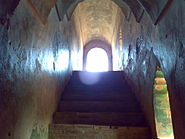| Talatal Ghar তলাতল ঘৰ | |
|---|---|
 | |
 Talatal Ghar or "The Rangpur Palace", Sivasagar (View of one of the wings of the Talatal Ghar) | |
| General information | |
| Architectural style | Ahom Architecture |
| Location |
Sivasagar Assam India |
| Coordinates | 26°55′25″N 75°49′36″E / 26.923611°N 75.826667°ECoordinates: 26°55′25″N 75°49′36″E / 26.923611°N 75.826667°E |
| Construction started | 1751 |
| Completed | 1769 |
| Client | Swargadeo Rajeswar Singha |
| Technical details | |
| Structural system | Bricks and indigenous varieties of cement |
| Design and construction | |
| Architect | Ghanashyam |
The Talatal Ghar (Assamese language: তলাতল ঘৰ [tɔlatɔl ɡʱɔɹ]) is located in Rangpur, 4 km from present-day Sivasagar, in Upper Assam. Of all Ahom ruins, it is one of the grandest examples of Ahom architecture. The Talatal Ghar, together with its above-ground counterpart the Kareng Ghar, is also the largest of all Ahom monuments.
History
Swargadeo Rudra Singha shifted the capital of the Ahom Kingdom from Garhgaon to Rangpur in AD 1702-03. For about a century thereafter, Rangpur remained the capital. It is located in the western part of Sivasagar. The earliest constructions were commissioned by Swargadeo Rudra Singha in AD 1698.[1][2] Rangpur was not only the capital of the Ahom Kingdom but also served as its military-station.
Architecture
- Talatal Ghar
The Talatal Ghar is a palace which was initially built as an army base. It houses two secret tunnels, and three floors below ground level which were used as exit routes during the Ahom wars (and which give the structure its name).
After Swargadeo Rudra Singha's death the Talatal Ghar, which together with the above-ground Kareng Ghar constitutes the "Rangpur Palace", went through many architectural alterations to its structure, which resulted in its irregular shape.
Rangpur Palace
- The Rangpur Palace is a seven-storied structure, four above ground (the Kareng Ghar) and the remaining three below ground (the Talatal Ghar). This seven-storied palace was completed by Swargadeo Rajeswar Singha and his successors, during AD 1751-1769.[3]
Talatal Ghar
- Swargadeo Rajeswar Singha added the three floors below ground, which make up the Talatal Ghar. This is made of brick and an indigenous type of cement (a mixture of Bora Chaul - a sticky variety of rice grain - eggs of hens, etc.). The Talatal Ghar had two secret underground tunnels. One, about 3 kilometres in length, connected the Talatal Ghar to the Dikhow River, while the other, 16 kilometres long, led to the Garhgaon Palace, and was used as an escape route in case of an enemy attack.[4]
Kareng Ghar
- From east to west, several rooms run along a long corridor; and from north to south are numerous smaller wings. The ground floor served as stables, store rooms, and servants' quarters. The Kareng Ghar was built mainly of wood, which was largely destroyed over time. The Royal apartments were on the upper storey, of which only a few rooms now remain, close to an octagonal room on the northern wing which once served as the Puja Ghar (prayer house). There are stairs leading up to the terrace. An isolated room stands on the south which is believed to have been used by the queen during her confinement.[5][6]
Visitors nowadays can only view the ground floor, the first floor, and what remains of the 2nd and 3rd floors of the Kareng Ghar. The floors of the Talatal Ghar below ground have been sealed off, and most of the wooden parts of the palace have disappeared over time.
The Rangpur Palace was once surrounded by a brick fortification and an earthen fort (Garh) with dikes filled with water. There is a Khar Ghar (gunpowder and ammunition store) near the palace.
Photo Gallery
See also
- Kareng Ghar, Sivasagar
- Rang Ghar, Sivasagar
- Sivasagar
- Charaideo
Notes and references
- Citations
- ↑ (Nath 2005:71–72)
- ↑ "Talatal Ghar - Kareng Ghar, Sivasagar, Rangpur, Ahom royal palace,sibsagar,assam,India". Onlinesivasagar.com. http://onlinesivasagar.com/tourism/talatal-ghar.html. Retrieved 2013-05-30.
- ↑ (Nath 2005:72)
- ↑ (Nath 2005:72)
- ↑ (Gogoi 1999-2000:27)
- ↑ (Archaeological Survey Report 1902-3)
- Bibliography
- Nath (2005). "Arowan". Rangpur Utsav Celebration Committee, Sivasagar.
- Gogoi (1999–2000). "Boranjiya Parasa Rangpur". Rangpur Tinisah Basar Otjapan Samiti, Sivasagar.
- Archaeological Survey Report (1902-3). "Archaeological Survey Report". Government of India, Bengal Circle.
| ||||||||||||||||||||||||||||||||||||||||||||||||||||||||||||||
The original article can be found at Talatal Ghar and the edit history here.



